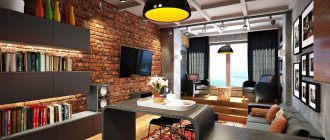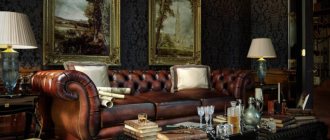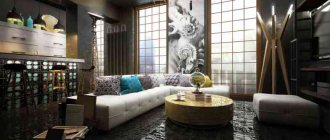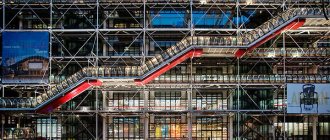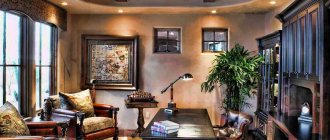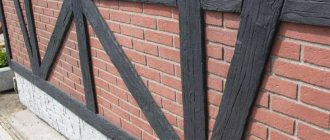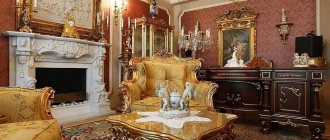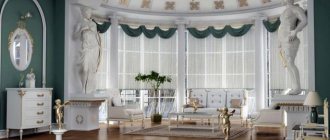History of the origin of the Empire style
We owe the appearance of the Empire style to the famous French Emperor Napoleon the First. It was during his reign that the transition from the era of classicism to a new, more solemn and triumphant trend in art took place.
Napoleon Bonaparte (Jacques Louis David)
It is worth saying that the Empire style incredibly accurately suited the historical period in which it originated, the period of great conquests, great wars, huge armies and majestic empires.
The name "empire" comes from the French word "empire" - empire.
The second country where the new movement in art became widespread, oddly enough, was the Russian Empire, the main enemy of France during the Napoleonic Wars. It got its start in the second half of the reign of Alexander the First. The construction of the Mikhailovsky Palace, the building of the Moscow Bolshoi Theater, the Gagarin Estate and other objects belong to this period.
Alexander the First (portrait of George Doe)
However, the “Russian Empire” received its main development during the reign of Nicholas I.
The secret of other style names
Classicism as a movement in architecture arose in the 16th century. Its distinctive features are called symmetry and restraint.
- The early period of development is Palladianism.
- The late stage of the classical movement, which is distinguished by solemnity and pomp, sounds like an empire style (the French word empire is empire).
Since the high classicism of the 19th century was born out of interest in history, archaeological excavations and discoveries of Ancient Egypt and Greece, some art historians attribute it to neoclassicism (a branch of historicism), which is logical.
The main features of the Empire style
An obligatory feature of the “imperial style” is an appeal to the culture of ancient Rome, ancient Greek city-states and other states of the Hellenistic era. The Empire style often uses elements that emphasize power, military superiority, and state power. It is no coincidence that this trend in art flourished during a period of strong states and the enormous importance of the armed forces of the countries.
Altar of Peace (art of ancient Rome)
The Empire style has found its place in various branches of human activity. Many artists, sculptors, fashion designers and designers often use elements of the 19th century era in their works to give them a special look, aesthetics and significance.
Empire style in architecture
The “imperial style” gained particular popularity in architecture, where it is characterized by the following features:
- The presence of columns, stucco, antique sculptures and strict lines.
- The symmetry of the elements must be strictly observed and balance must be maintained.
- Rich decorations, military elements, massiveness and monumentality.
Probably the most famous architectural structure erected in this era is the Arc de Triomphe in Paris.
Arc de Triomphe in Paris
In 1806, by order of Napoleon Bonaparte, construction of this monumental structure began. The work lasted for 30 years and was carried out under the leadership of three architects, however, F. Chalgrin was considered the main one.
Art historians consider the Roman Arch of Titus to be the prototype of Chalgrin's work.
Arch of Titus in Rome
The Vendôme Column is an equally monumental and significant structure of the Napoleonic era. The creators of this column are J. B. Leper and J. Gondoin. The work was done in honor of the victories of the French Emperor and the Trojan Column was taken as its basis. Here you can also trace the appeal to the themes of antiquity and military achievements.
In the Russian Empire, the most famous architect of the Empire style is considered to be Carl Rossi, the author of the projects of the Mikhailovsky Palace, Palace Square and the General Staff building.
Main headquarters building in St. Petersburg
However, we should not forget such famous people as: A. Zakharov, D. Gilardi, O. Montferan.
Admiralty building designed by Zakharov
I. Martos is considered the main sculptor of the Russian Empire style. Ivan Petrovich put his hand to the following historical sculptures: the monument to Minin and Pozharsky on Red Square, the monument to Alexander I in Taganrog, as well as the bronze statue of John the Baptist on the portico of the Kazan Cathedral in St. Petersburg. Sailor's works are of particular value for Russian culture and are a national treasure.
At the end of the 40s of the 19th century, a new approach to creativity came to replace it - historicism. In the 1930s, a “rehabilitation” of this architectural style was carried out in the form of the so-called “Stalinist Empire”, which acquired the features of Russian constructivism
The Chkalov staircase in Nizhny Novgorod as an example of Stalinist Empire architecture
The building of Moscow State University is an example of the Stalinist Empire style
Stalin Empire style
The Russian Empire style occupied a dominant position in the monumental and architectural art of the Soviet Union in the 1940-50s. The decor of various rooms is dominated by massive wooden furniture, bronze figurines, lamps, as well as stucco molding under ceilings of considerable height.
Stalin's skyscrapers, located in the capital, are a symbol of the Stalinist Empire era and, in particular, architecture. In Moscow, by the end of the 1950s, 7 of the tallest buildings of that time were erected.
The Stalinist Empire style combines Baroque interior design, images of the Napoleonic era, (late) classicism and Art Deco ornaments.
The clearest example of an interior design organized in this direction is the banquet hall located on the premises of the Central Moscow Hippodrome. The photo clearly shows the strict features of the Empire style in the architecture of the building.
Central Moscow Hippodrome
When decorating the interior of furniture, carvings are used. On the surface of cabinets and cabinets you can see reliefs in the form of five-pointed stars, ears of corn and laurel wreaths.
An important role in the Stalinist Empire style was played by chandeliers, which not only illuminated the rooms, but were also distinguished by a representative, solemn appearance. They were made of bronze and decorated with crystal pendants. To organize the decor of various rooms, materials of exclusively natural origin were used - marble, bronze, crystal, ceramics, wood.
Empire style in painting
The main representative of the Empire style in painting is the French painter Jacques Louis David.
His main works are: “Napoleon at the Saint Bernard Pass” and “Portrait of Madame Recamier”.
Bonaparte at the Saint Bernard Pass. Jacques Louis David
Paintings in the Empire style are characterized by the following features:
- majesty,
- pride, antique moods,
- aesthetics of war and victories.
Portraits of women in Empire style paintings are full of majesty and imperial pride. Such paintings depicted representatives of the upper classes.
Empire style in the interior
Main features
“Imperial style” is also ideal for arranging interior decoration. An Empire style interior should have the following features:
- Expensive and luxurious decor;
- Elements of classical architecture (columns, pilasters, stucco moldings, sculptures);
- The presence of ancient culture (images of animals, warriors, etc.);
- Gold, bronze colors. Metal inserts, paintings and antiques;
- Eclecticism.
Previously, only representatives of the upper class could afford to decorate housing according to the patterns of late classicism. Empire style requires large space and “imperial” scope. Therefore, the rooms need to be large and spacious, with wide windows and high ceilings.
Often, living rooms and bedrooms are decorated in the Empire style to emphasize the high status and financial position of the owner of the house. These rooms are ideal for decoration in this style.
Living room design example
When creating an interior, massive furniture with metal inserts, decorative legs and expensive decor is used. Particularly important elements are the luxurious chandelier and wall decor.
Empire style bedroom
Interior design and architecture
Empire is a majestic imperial style in interior design, the favorite brainchild of French classics during the reign of Napoleon Bonaparte. The Empire style received its formation and development at the beginning of the 19th century. At that time, the French emperor waged endless wars of conquest in Europe and some African countries.
The Empire style came into fashion at the instigation of Napoleon himself - and fully corresponded to the emperor’s taste preferences in interior design. After the famous historical events of 1812, the imperial style quickly spread throughout Russia. It gained great popularity among the Russian nobility by the mid-19th century, but at the same time it had a characteristic difference, which was the use of bright and catchy elements.
Characteristic features of the style.
Among the distinctive features of the Empire style are the following:
- the presence of military paraphernalia and symbols in the design;
- the use in interior decoration of forms characteristic of Roman architecture (columns, capitals, portals, arched openings and ancient statues);
- decorative elements of an Egyptian character (figurines of pyramids and sphinxes, pharaoh masks, skins of exotic animals);
- monumentality, severity and luxury of the interior. The empire style with every detail was intended to emphasize the greatness and exclusivity of the emperor’s personality;
- heraldic elements and monograms in interior design.
Empire style in modern times.
Today there are also many fans of interior design in the Empire style. This style presupposes the presence of massive and solid interior decoration elements, and therefore is suitable exclusively for large areas.
In a small room it is almost impossible to maintain the characteristic design features of the imperial style - solely due to the lack of space for the proper scope.
Interior decoration.
The Empire style is characterized by the use of high-quality materials, which have long been used to decorate expensive interiors. This is an abundance of gilded details, silk and velvet curtains and draperies, as well as natural marble and precious mahogany.
All materials used in decoration must be of natural origin, because modern artificial analogues will not be able to recreate the true luxury of the imperial style.
Silk fabric of a single color is most often used for wall decoration. Patterned wallpaper with ornaments or geometric patterns are absolutely not suitable for embodying the Empire style. As an option, you can use smooth, single-color wallpaper.
In the corners of rooms, as well as under the ceiling, it is possible to use stucco decorations - and they should also be natural, in no case made of plastic or foam. Only real stucco should be used.
But with finishing the ceiling, everything is very simple - it is best to paint it with white, plain paint. This will be much easier than painting in the form of frescoes on scenes from Ancient Rome.
Natural high-quality wood or stone is used to finish the flooring. It is possible to use parquet or stone mosaics of different shades. A beautiful carpet with luxurious pile and exotic pattern will be an excellent addition to the integrity of the Empire style picture.
Antique details.
In the classic interior of the imperial style, architectural elements from the times of Ancient Rome are often used. These could be columns, massive statues of ancient heroes, or arched openings decorated with stucco scenes from Roman history.
For the Empire style, there are certain characteristic features of furniture design. Thus, massive table legs are made in the form of columns, and the legs of sofas, armchairs and chairs look like animal paws. The corner parts of the cabinets are shaped like capitals. The imperial-style interior breathes history and noble, good antiquity, which remains relevant for many centuries.
Color spectrum.
The Empire style is characterized by the use of pure, bright and rich colors: red, blue, emerald green, gold. pure green, as well as white and black. Most often, one base color is used in interior design, or a combination of two bright and contrasting colors is used.
Shine and shine.
Also, the classic imperial style is characterized by an abundance of gilded elements (candlesticks, frames on paintings and mirrors, details of chandeliers and lamps) and many lacquered surfaces. Crystal chandeliers with many sparkling pendants help to emphasize the luxury and splendor of style.
Polished furniture can also be used to create a harmonious interior in the Empire style. The presence of a large number of mirrors in the interior of the room is also one of the most characteristic features of the imperial style. There should be a lot of mirrors, and at the same time they are located everywhere: on the walls, between window openings and on furniture doors.
Decorative elements.
The most organic items for the Empire style are decorative military-themed items: swords, swords, sabers, shields, armor and ancient axes. For passionate fans and collectors of weapons, the Empire style will be a great opportunity to display their treasures for everyone to see.
In addition to weapons, large-scale canvases depicting military battles and historical subjects are excellent for the Empire style. These paintings must be very large in size, so they simply will not fit in a small room; they require a room with a more impressive area.
Also, the Empire style is characterized by the use of Egyptian figurines, souvenirs of pharaoh masks and other rare souvenirs brought from Egypt. However, there should not be too much, so as not to overload the interior with details.
Empire style in graphic and web design
With the development of technology and the Internet, many areas of art began to flow into the computer sphere. Empire style was no exception. Today, designers often resort to this type of design to highlight their work in the market.
First of all, it is worth saying that such a design is not suitable for every project.
For example, for pages of official government structures, museums, banks, historical sites and galleries, the Empire style would be the best choice.
Tinkoff's corporate identity is designed in an empire style
Empire style design primarily expresses the premium and prestige of the represented brand.
Bar logo design for the premium segment
Colors and shapes
You should not use a large number of colors, it is better to focus on two of the following basic shades:
- gold,
- emerald,
- dark blue,
- red
- white colors
They are most consistent with this type of design and create a special atmosphere.
The use of military paraphernalia, images of sculptures of Ancient Rome, mythological motifs - all this is welcome when creating graphic or web design with Empire elements.
Logo with military paraphernalia
But most often the Empire style in graphic design is expressed in the use of antique patterns and geometric textures.
An example of a texture from an antique pattern
Vignette design in Empire style
Fonts
The font is extremely important. When designing, you must use only strict fonts, without unnecessary elements or embellishment.
It is worth using bold lines to emphasize particularly important points in the text; this gives the text special significance and indicates a serious attitude towards cooperation or work.
Empire style typography example
For headings and logo elements, graphic fonts with features characteristic of the entire Empire style can be used.
An example of a graphic font in the Empire style
Empire style in fashion
Empire style is often used in modern fashion, by representatives of both sexes. Most often, clothes in this style are worn on special occasions, but sometimes in everyday life.
Typically, the “imperial outfit” is chosen by people who want to emphasize the elegance of their body, love of aesthetics and efficiency.
Often the person who dresses like this is very calm and cold, he is not used to tolerating inconvenience and ignorance. Secular ladies and their husbands often turn to the era of the 19th century when choosing a costume, to the images of commanders and ladies-in-waiting of that era.
19th century dress in Empire style
Empire style corduroy dress
Women's attire of this era is particularly luxurious. Almost always this is a dress with bare shoulders, a deep neckline, gold inserts, a high waist, sparkles and rhinestones. These features are also inherent in modern fashion.
Empire style dress (Broke Collection – Vogue)
Sheer Empire lace dress (Broke Collection – Vogue)
Empire style dresses are also light and elegant at the same time.
Elegant black dress in Empire style
Interpreted for every day, empire style dresses most often have a Greek silhouette.
Empire style dress in business style
Light romantic dress with Empire silhouette
The essence of empire style in modern fashion is considered to be the white dress of the bride at a wedding.
Empire style wedding dress
Silver and bronze in Empire style
The imperial style suited bronze items perfectly. Their forms are simple, the surface is tinted with a patina, and the decor is reminiscent of antique frescoes: heads or figurines resembling cameos surrounded by a curlicue pattern, authentic symbols, intertwined cornucopias. The ornament is executed impeccably, maintaining the Empire status.
Candlesticks, second half of the 19th century.
The candlesticks are made in the Empire style from patinated bronze. The basic shape perfectly conveys the antique columns. The trunks of the candlesticks are decorated with elegant capitals, and the carving on the candlestick allows the reflections of the fire to play along the carved paths. The lion heads at the base represent the connection between past and future, being the most typical attribute of Egyptian culture.
Chic bronze chandeliers in the Empire style. Large, more than a meter in height, they consisted of many candlesticks and were designed for huge halls. Decorative and sculptural elements made the object not so much utilitarian as a work of art.
Chandelier of twelve arms. Porcelain, gilded and patinated bronze. Paris, 1895
Objects made of silver from this period often copied the shape and designs of marble products and ceramics of ancient Greece, Egypt and the Roman Empire. For example, the famous Warwick, Buckingham and Portland vases, found at the end of the 18th century during excavations in Greece, are embodied in silver and become objects of imitation for many jewelers. The refined, often flat, embossed or engraved decor of the first half of Neoclassicism was abundantly replaced by larger architectural motifs and voluminous cast decorations in the antique spirit: laurel garlands and wreaths, acanthus leaves, heads and paws of eagles, swans, panthers, sphinxes, female figures and masks , similar to the ancient Greek ones. There is a revival of heraldry, especially noticeable in English silver. The principles of architectural classical forms and proportions are vividly embodied in candlesticks and candelabra: popular models of Doric, Ionic and Corinthian columns, smooth, relief, rectangular, multifaceted, rectangular, reminiscent of Egyptian obelisks. Silver tableware still retains the graceful outlines of antique vessels, but spherical objects appear, reminiscent of a globe or pumpkin.
In the production of tableware, new technological methods of metal processing are widely used, best suited for the geometric and symmetrical forms inherent in Neoclassicism. This made it possible to significantly increase the number of elegant dishes made of thin light silver or silver-plated alloys, as the demand for such products increased unprecedentedly during the imperial period. The Bateman family's plate rolling mill produced large quantities of thin silver plates that could be easily cut, melted, twisted, and bent. Plates of similar properties and high quality, only in combination with copper, were produced at a plant in Sheffield. Technology gradually spread from England throughout Europe, then to America.
A silver dish in which the cornucopia motif is repeated multiple times. Christian Ludewig Kuhfeldt, Berlin, 1830
French oil and vinegar set made of silver and crystal. 1830
Another set from Liege for oil and vinegar, made of silver with glass decanters. 1830
Classic models of French silver gravy boats from the Empire period with handles made in the form of panther, griffin and swan heads. Around 1830
Silver container for serving vegetable dishes. 1803
Brandenburg tureen. A smooth surface, raised handles, and a high lid are typical for imperial style silverware. 1801 -1803
Silver confiture fryer with a transparent glass insert and twelve spoons in a set. Paris, around 1830
Two coffee pots with bodies characteristic of the Empire style in the shape of antique vases and a base in the form of a tripod, cast palmetto decorations, a dotted pattern along the circumference of the neck and spouts, with a stylized head of a lion and a swan. Work by D. G. Garro, Paris, 1819 - 1830.
Silver samovar in Empire style. 19th century
Silver tea and coffee set by Victor Saglier in the Empire style. Mid 19th century
A container with a lid in the shape of an antique urn by Jean Nicolas Boulanger. The curved handles are decorated with dolphin heads. Silver, glass. Around 1810
Silver confiture maker by Herbert Denoyer in the form of a tripod with stirrup wings and winged caryatids. The set contains 12 gilded spoons. Egyptian and Hellenic styles are mixed. 1820-1832
A samovar made of gilded silver in the Egyptian style, made by London masters D. Scott and B. Smith in 1806. Three figures of sphinxes support the body of the samovar and rest their paws on a tripod
Duncaster trophy cup in gilt silver, created by Rebecca Eames and Edward Barcard in 1828. Bacchanalian figurines in ornament and serpentine handles were often used for both exhibition and home silver
Sketches from Hirst's album for the Sheffield plates reflect patterns for candlesticks in the form of Doric (left), Ionic (middle picture) and the most decorative Corinthian columns.
